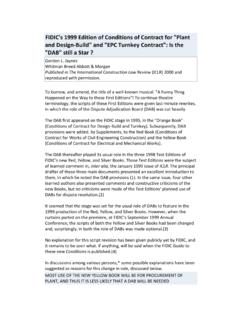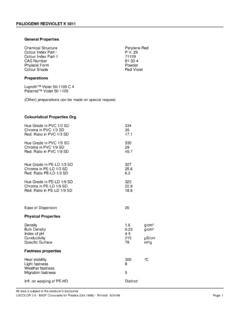Transcription of Clause 13 Variations and Adjustments - Corbett
1 Clause 13. Summary Sub- Clause deals with the right of the Engineer to vary the Contract. This right can be exercised at any time up to the issue of the Taking-Over Certificate. Sub- Clause deals with value engineering and permits the Contractor to propose a change which will benefit the Employer. The proposal is prepared at the cost of the Contractor, who designs the change. Sub- Clause deals with the procedure prior to the Engineer instructing a variation. The Engineer may request a proposal from the Contractor. However, while the Contractor is preparing the proposal it must proceed with the works. Sub- Clause deals with payment in applicable currencies. Sub- Clause deals with Provisional Sums and ought to be read with Sub- Clause which defines Provisional Sum as follows:- a sum (if any) which is specified in the Contract as a provisional sum, for the execution of any part of the Works or for the supply of Plant, Materials or services under Sub- Clause [Provisional Sums]. The Provisional Sum can only be used where there is an Engineer's instruction and the Contractor receives payment for only the work done to which the Provisional Sum relates.
2 Sub- Clause deals with daywork. This is where work of a minor or incidental nature is to be carried out. The work is then valued in accordance with the Daywork Schedule in the Contract or if there is no Daywork Schedule then the alternative method of payment as prescribed in the Contract. Sub- Clause deals with the Cost arising from changes in the Laws of the Country which affect the Contractor in performance of his obligations under the Contract. Where the Contractor suffers delay or additional Cost then it must give notice under Sub- Clause of the Contract. Sub- Clause deals with Adjustments for changes in cost. This Sub- Clause only applies where the table of adjustment data included in the Appendix to Tender has been completed. If the Sub- Clause does apply then the amounts payable to the Contractor for rises and fall in the cost of the Works are adjusted by a formula. Origin of Clause The right to vary work was found in Clause 51 of the Red Book 4th edn and 3rd edn. There are, however, substantial differences.
3 In particular the clarification in Clause regarding an increase or decrease in quantities has been omitted from FIDIC 1999. This is a retrograde step. Sub- Clause (Value Engineering) is a new Clause although it had been included at Sub- Clause of FIDIC's Orange Book. Sub- clauses and 1. The content of this commentary is not legal advice. You should always consult a suitably qualified lawyer regarding a particular legal issue or problem that you have. Please contact us if you require legal assistance. Corbett & Co International Construction Lawyers Ltd 2016. were found at Clause 53 of the Red Book 4th edn. Once again these clauses have been substantially changed. Sub- Clause is a new Clause , although currency proportions were dealt with at Clause 72 of the 4th edn. Sub- Clause has its origins in the 3rd edn of the Red Book and is found at Clause 58 of the 4th edn. One complaint regarding Clause 58 in the FIDIC 4th edn was that there was no definition of Provisional Sum; this has been rectified in FIDIC.
4 1999. Sub- Clause is similar to Clause of both 3rd edn and 4th edn Red Books. Sub- Clause was previously found at Clause of the 4th edn Red Book, in a much simplified form. Cross-references References to Clause 13 or Provisional Sum are found in the following clauses :- Sub- Clause (Definitions Provisional Sum);. Sub- Clause (Definitions Variations );. Sub- Clause Instructions of the Engineer;. Sub- Clause Sufficiency of Accepted Contract Amount;. Sub- Clause Unforeseeable Physical Obstructions;. Sub- Clause Definition of nominated Subcontractor ;. Sub- Clause Payments to nominated Subcontractors;. Sub- Clause Testing;. Sub- Clause Programme;. Sub- Clause Extension of Time for Completion;. Sub- Clause Prolonged Suspension;. Sub- Clause Cost of Remedying Defects;. Sub- Clause Evaluation;. Sub- Clause The Contract Price;. Sub- Clause Application for Interim Payment Certificates;#. Sub- Clause Payment of Retention Money; and Sub- Clause Currencies of Payment. Sub- Clause Right to Vary This Sub- Clause gives the Engineer the right at any time prior to the issue of the Taking- Over Certificate to initiate a Variation either by an instruction or by a request for the Contractor to submit a proposal.
5 The Contractor is obliged to carry out every Variation unless he cannot readily obtain the Goods required for the Variation. 2. The content of this commentary is not legal advice. You should always consult a suitably qualified lawyer regarding a particular legal issue or problem that you have. Please contact us if you require legal assistance. Corbett & Co International Construction Lawyers Ltd 2016. Variations may include (a) changes to quantities;. (b) changes to quality or other characteristics;. (c) changes to levels positions or dimensions;. (d) omission of work unless it is to be carried out by others;. (e) any additional work Plant Materials or services necessary for the permanent Works including tests; or (f) changes to the sequence or timing of the Works. The Contractor may not make any alteration or modification of the Permanent Works unless a Variation has been ordered. The power to vary is an essential part of every construction contract but the scope of the power to vary differs considerably between different forms.
6 Sub- Clause confers a very wide power and it will only be in unusual circumstances that the Contractor will not be obliged to follow a variation instruction. There is no useful definition of the term Variation . The definition in Sub- Clause is not very helpful: 'Variation' means any change to the Works which is instructed or approved as a variation under Clause 13 [ Variations and Adjustments ]' . This at least makes it clear that any instruction about the Works not instructed or approved as a variation under Clause 13 is not a Variation. This has implications when an Engineer issues an instruction under Sub- Clause Sub- Clause attempts to deal with this by stating that If an instruction constitutes a variation, Clause 13 [ Variations and Adjustments ]. shall apply . Thus it seems that contrary to Sub- Clause , a Variation is not only a change to the Works instructed under Clause 13 but may also be instructed under Sub- Clause For an instruction to amount to a Variation the Contractor must act on it.
7 In Obrascon Huarte Lain SA v HM Attorney General for Gibraltar 1 the Engineer issued a document entitled draft fill guidelines, which gave directions about undertaking certain works, which if implemented would have amounted to a Variation. The Contractor, however, chose not to act upon the draft fill guidelines when removing contaminated material from site and dealt with the contaminated material by another accepted method. The Court of 1. [2015] EWCA Civ 712. 3. The content of this commentary is not legal advice. You should always consult a suitably qualified lawyer regarding a particular legal issue or problem that you have. Please contact us if you require legal assistance. Corbett & Co International Construction Lawyers Ltd 2016. Appeal therefore stated: Accordingly the issue of the draft fill guidelines did not constitute a variation instruction.. In the normal course of virtually every construction contract the Engineer will give instructions which he wishes to be treated as being entirely within the scope of the Contract and thus not a Variation.
8 However one of the most common causes of dispute between the Contractor and the Engineer and the Employer, is the Contractor's belief or assertion that this instruction in fact takes him outside the scope of his obligations and is thus a variation. Although it is not a standard term, it is very common for Employers to include a particular condition in contracts which limits the Engineer's authority to instruct a variation. If the Contractor is aware of this limitation (as he almost always is) he is not obliged to follow an instruction which he considers to be a variation unless the Engineer can demonstrate that he has the required authority to issue it. One of the most common disputes under construction contracts is where the Contractor and the Engineer differ on whether a particular instruction is or is not a variation. If the Contractor considers that the instruction constitutes a Variation he will make an application for payment on that basis, and, if the Engineer refuses to pay, the issue will become a matter for dispute.
9 The Contractor is required to follow the Sub- Clause [Contractor's Claims] procedure. Where, as is common, the Engineer issues an instruction, believing it to be a simple instruction and not a Variation but it is subsequently shown to be a Variation, but the Engineer had no authority to do so because of a limitation imposed by a Particular Condition in the Contract, the Contract provides no clear solution. The Employer can argue that, under Sub- Clause , the Contractor is expressly forbidden from carrying out a Variation unless there is a variation order. Whatever the Engineer may have done, he did not issue a variation order as that was outside his authority. The Contractor will argue that he acted in good faith by following an instruction which, at the time, the Engineer clearly considered to be within his authority. Indeed at the time the Contractor may not have realised it was a variation. An example of this is the following: In a road rehabilitation project a particular condition forbad the Engineer from issuing a Variation Order without prior approval from the Employer.
10 The design of the project required the contractor to level the existing seriously degraded pavement and then to place a well graded capping layer both over any exposed sub-surface material and over any remaining original pavement. The design assumed that the sub-surface material had 4. The content of this commentary is not legal advice. You should always consult a suitably qualified lawyer regarding a particular legal issue or problem that you have. Please contact us if you require legal assistance. Corbett & Co International Construction Lawyers Ltd 2016. good bearing qualities. Once excavation started it began to become apparent that the sub- surface material was of very poor bearing quality and that it would be necessary to replace much of the capping layer with a crushed rock material. Such material was already specified for soft spots and the Engineer initially ordered greater quantities of the soft spot material. Eventually this became the main material to be used in place of the capping material for a large part of the road.









